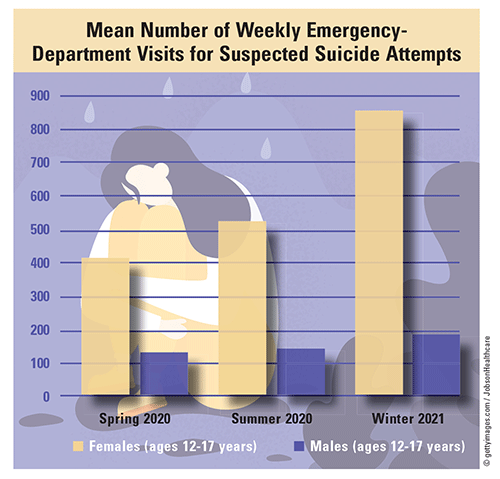US Pharm. 2022;47(8):14.
Suicide rates in the United States increased by 30% from 2000 to 2018 and decreased by 3% from 2019 to 2020. However, the National Vital Statistics System determined that rates increased among adolescents and young adults. According to the CDC, youths aged 10 to 24 years account for >6,500 suicide deaths, or ~14% of all suicides. Suicide is the third leading cause of death among adolescents and young adults (ages 15-24 years) and the second leading cause of death among younger adolescents (ages 10-14 years).

Suicide Attempts: In a CDC survey, 44% of U.S. adolescents reported feeling “persistently sad or hopeless”—versus 37% before the COVID-19 pandemic—and 20% of them have contemplated suicide, likely due to pandemic-related stressors affecting their mental well-being. Mental health (MH)–related emergency-department (ED) visits by youths aged 12 to 17 years increased by 31% from 2019 to 2020. Youths aged 10 to 24 years exhibited the greatest increase in ED visits for suspected suicide attempts, including intentional self-harm, during the pandemic. The National Syndromic Surveillance Program reports a 48% increase in ED visits for suspected suicide attempts by U.S. females aged 12 to 17 years during the 2021 winter surveillance period versus the 2020 spring surveillance period. Overall, the rate of ED visits for suspected suicide attempts was 51% greater in females and 3.7% greater in males aged 12 to 17 years during the 2021 winter surveillance period versus 2019 prepandemic rates.
Use of Psychological Services: NRC Health data indicate that nearly 43% of U.S. parents delayed their children’s healthcare (HC) during the pandemic. The 2022 Pediatric Consumer Trends Report reveals that parents are beginning to use HC services again, with a 135% increase across all major HC settings (including EDs) and a 133% increase in psychological care via telehealth services from 2020 to 2021. However, 12.5% of parents are uncertain about when they will resume family members’ HC activity, and 5.5% report no plans to seek future HC services.
National Suicide Prevention Lifeline: In July 2022, the Federal Communications Commission launched a nationwide three-digit dialing code, 988, for suicide prevention and MH crises. The 988 line provides access to trained counselors from more than 200 crisis centers in the existing National Suicide Prevention Lifeline network. The National Suicide Prevention Lifeline number, 1-800-273-TALK (1-800-273-8255), and the Crisis Text Line (text TALK to 741741) remain available to assist people in emotional distress or suicidal crisis. The Lifeline’s network of counselors are trained to listen, provide support, and connect people to resources while working lessening stigma surrounding suicide and MH conditions.
The content contained in this article is for informational purposes only. The content is not intended to be a substitute for professional advice. Reliance on any information provided in this article is solely at your own risk.
To comment on this article, contact rdavidson@uspharmacist.com.





